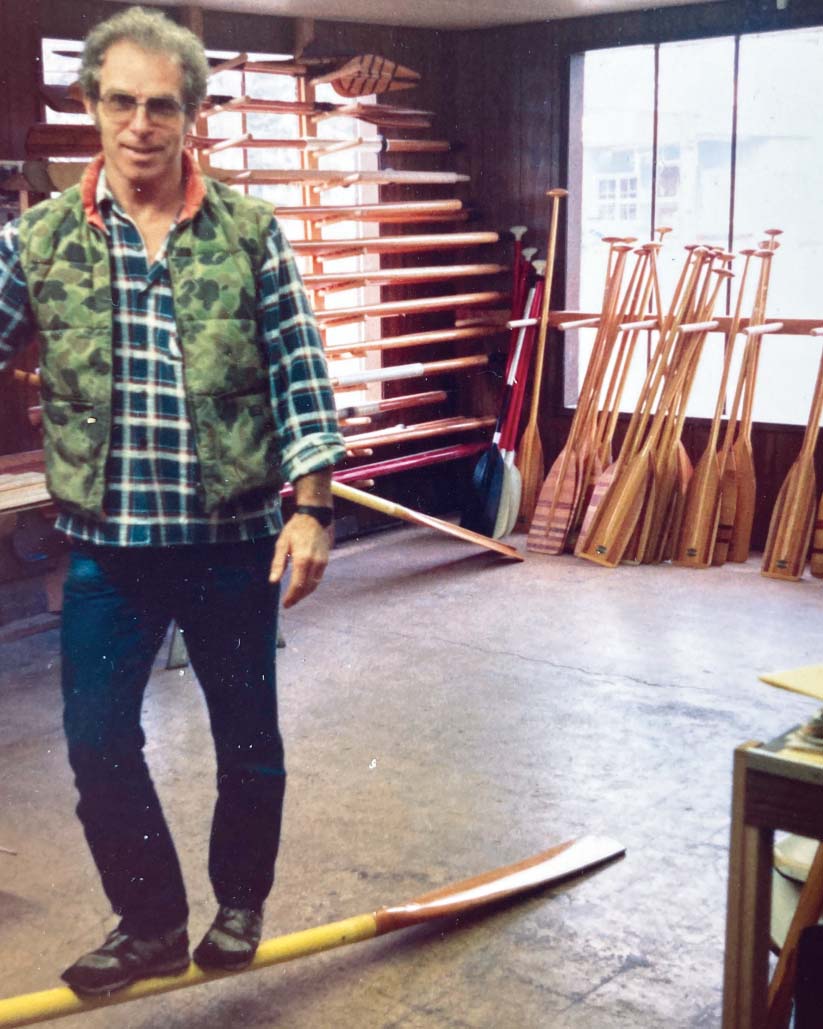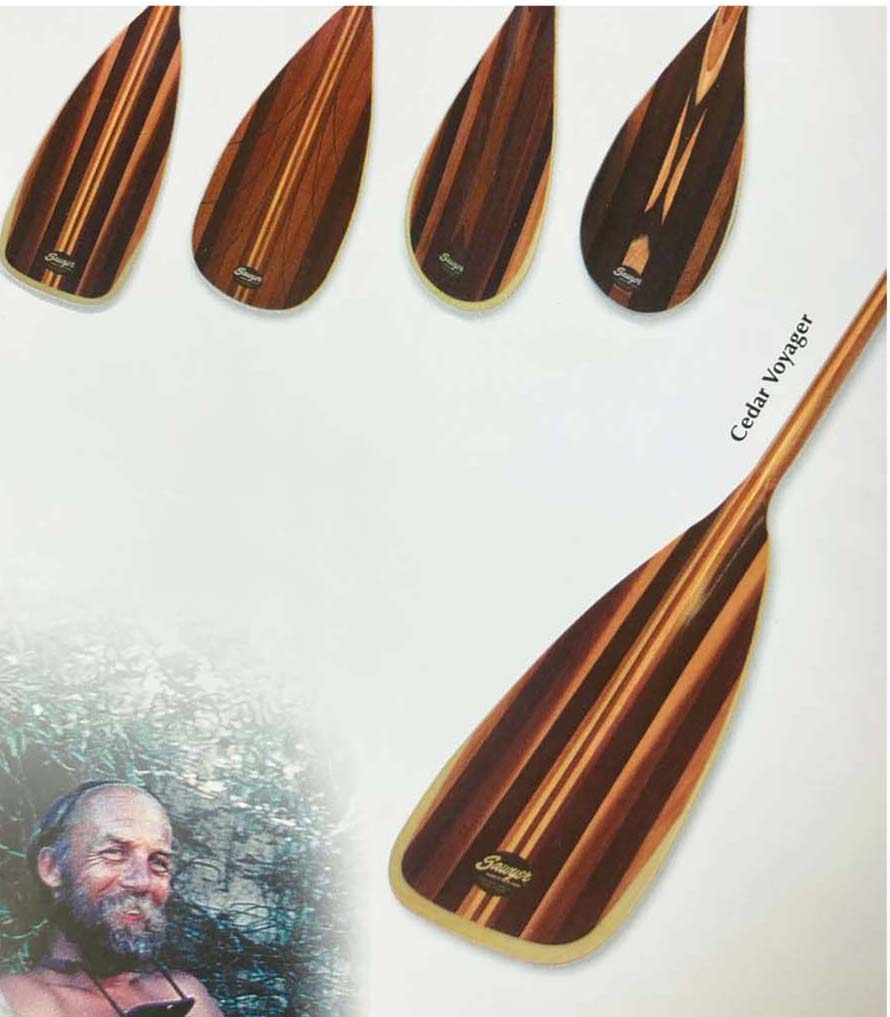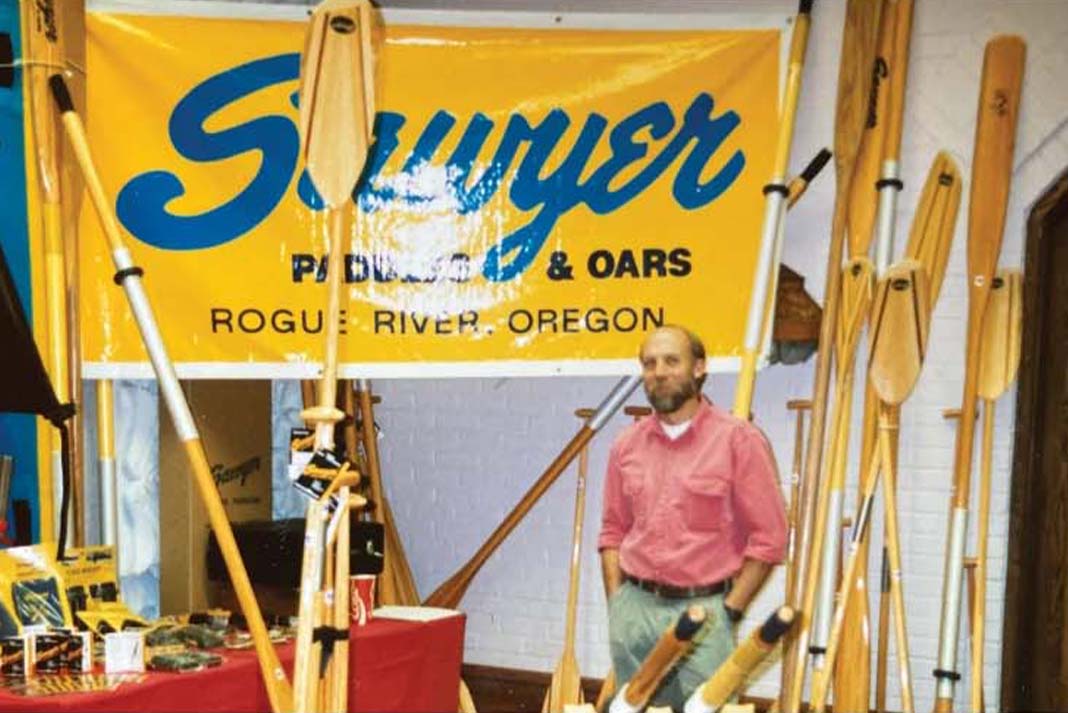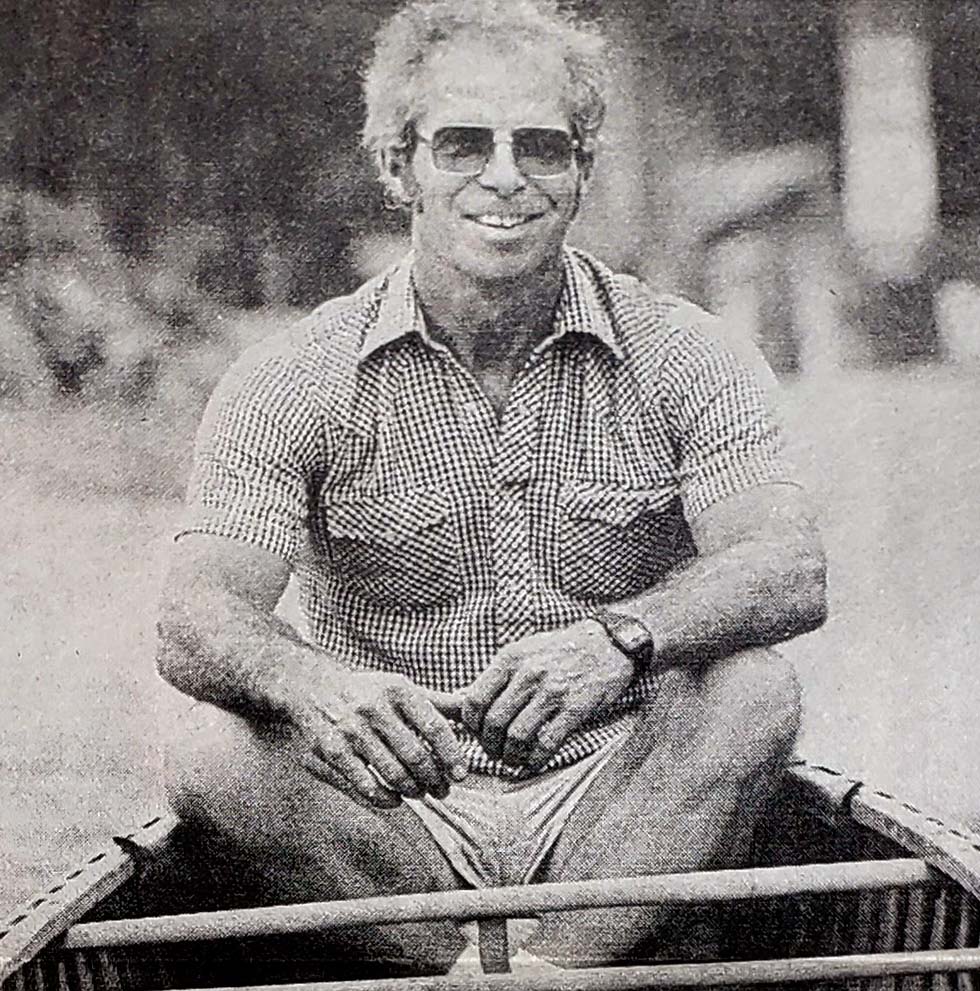Products You May Like
“Maravia hits its 50th anniversary this year, and Cascade River Gear has been in business for 43 years. It’s important to tell the story of legacy river companies because it’s a small and very niche market. For companies like ours to last, we have to work together and strive to improve our products and services on an ongoing basis.”
Angela Sherman, former river guide and Chief Operating Officer, Maravia Rafts and Cascade River Gear
Legend has it that Ralph Sawyer never really wanted to get into the oar business in the first place. A renowned Great Lakes marathon canoeist, in 1967, he broke free from Michigan and put thousands of miles between himself and his partners at Sawyer Canoe Company. Ralph was content to run the handcrafted wooden paddle division from Rogue River, Oregon, and sink into his newfound love: west coast whitewater.
Meanwhile, Willie Illingworth was a Southern Oregonian fervently searching for the perfect drift boat design. Out of a mutual affinity for hand shaping innovative boats and boat components, Willie searched Ralph out and unrelentingly pestered him into fashioning wooden oars for his yet to be manifested dream boat. After all, who better for the job than a pro wooden canoe paddle builder. When Willie began constructing his now signature aluminum, McKenzie style drift boat, Ralph gave in and handcrafted his first set of wooden oars for Willie.
Unbeknownst to either party, this first partnership was the moment of inception for what would be Sawyer Paddles & Oars unchallenged reign as an industry leader in the niche market of wooden (and composite) oars (and paddles) for decades to come.
According to Jim Bittle, current Willie Boats CEO, one through-line has always remained the same between the companies; a strong ethic toward collaboration with each other and industry wide. Bittle states, “There is power in numbers and partnership. Companies with well-grounded relationships can tackle obstacles and finish strong. Both companies value where we are now and understand how we got here. Over the years, Willie Boats has worked with Sawyer owners Ralph Sawyer, Bruce Bergstrom, Pete Newport and the current leadership team, Zac Kauffman (CEO), Israel Ramirez (Operations Manager), and Shyne Tourville (Production Supervisor) to develop oars that are unrivaled in the industry.”

Innovation Station
Oars have always been a focal point at Sawyer. Staying true to their origin story, if you look at the sum of total revenue at Sawyer as a fully outfitted vessel, splitting up product categories in the de-rig, oars make up 65% with an undercurrent of 35% paddles in overall sales.
To get a sense of the trajectory of oar technology and design over the last half-century and the role Sawyer has played in that evolution, one needs to consider that since inception, Sawyer has been primarily guided by the lens of a canoeist (Ralph) and/or a drift boater (Willie).
What do these two watercraft have in common? They are rigid boats requiring a discerning and detail-oriented pilot to operate successfully. Canoeists and drift boaters frequently refer to running rapids in their rigid crafts as dancing on water. The nuance of each stroke and the interplay with whitewater can be far more consequential than that of a raft or inflated vessel.
Throughout Sawyer’s tenure, they have continually partnered with the nation’s top drift boat companies. More recently, Stealth Craft (Michigan) since 1996, Stream Tech Boats (Idaho) since 1997 and Adipose Boat Works (Montana) since 2010. Even before the partnership, often for decades, many operators worked closely with Sawyer as guides and customers, sharing product feedback and design perspectives.
Most paddle and oar companies haven’t had the blessing (and curse) of design progression heavily influenced and, in some cases, completely driven by rigid water crafts. A blessing to the end-user regarding oars because the final product shows enhanced precision and detail for which all river user groups benefit, drift boaters and rafters alike.
This guiding light has been the foundation of Sawyer’s ability to simultaneously stay true to their roots in producing homegrown wood paddles and oars as well as break the mold and recast oar design with innovative technology that utilizes emerging market materials. A bearing toward tradition and innovation combined with thoughtful explorations of expansion and acquisition are the components that, when assembled with artisan’s hands, have made Sawyer as a whole a world-renown paddle and oar manufacturer.

Pioneering and Trailblazing
The first time Sawyer broke the mold was in 1969 with the Sawyer Light oar. They were originally shaped from laminated pacific northwest straight grain Douglas fir (a wood known for its light weight to high strength ratio). As their original bread and butter staple oar product, the spirit of this first wood oar model is infused in many oar models today and is still the go-to for guides and drift boaters.
By 1987 (five years after this article’s author was born), when Bruce Bergstrom stepped into leadership at Sawyer, the company had an excellent reputation for handcrafting quality, lightweight and durable paddles and oars. With such a great reputation, they were quickly outgrowing their Rogue River facility. Even better, they were poised to acquire their top competition.
In 1991 a larger manufacturing headquarters was opened in Talent, Oregon, and soon Smoker Paddles and Oars was incorporated, including their marquee product, the solid ash, heavy-duty Smoker Whitewater oar. Smoker was an all-wood oar company who made wagon wheel spokes at the turn of the century and started making oars in the 1930s. Keen to focus on other pursuits, they were eager to sell the oar division. With these major achievements notched in Sawyer’s belt, the company was free to initiate a tech revolution in the river industry. Materials revolution
By the 90s, composite materials had worked their way into the mainstream and were readily incorporated into many common consumer products as a cost-effective replacement for wood and metal. Bringing composite materials into paddle and oar manufacturing was one step towards modernization for Sawyer and one giant leap for the paddle industry.
Under Bergstrom’s leadership, flagship products made from wood, plastic and composite materials (sometimes merged into a singular oar) were brought to customers like never before. Hot commodities like crowd-pleasing SquareTop oars, rough-and-tumble burly DyneLite blades, fan-favorite MX shafts, the Polecat series and blending composite shafts with optional wood blades (and handles) allowed for wide market coverage over many price points and customer needs.
The origin of combining carbon fiber with wood started with a product called the Fir-Lam DyneLite (not in circulation since 2010) which shaft-wise was essentially a twin to the Sawyer Light, with a DyneLite Blade built on. At the time, mid-composite revolution, customers were shying away from wood a bit, and the product of this blended material kept Sawyer competitive. With a lightweight DyneLite blade and the soft flex of a wood shaft, the swing weight was smooth, and it was an overnight sensation.
Kauffman notes the only problem: “It wasn’t super beefy. From the get-go, the product was over-bladed and under-shafted.” Translation: Guides were maxing out the models’ capabilities on 18-foot rafts weighted down with eight plus passengers. The blade caught lots of current, and the high flex shaft couldn’t help but crack, buckle or break at the shaft/blade junction point. Out of Bergstrom’s desire to repair wooden shafts and reinforce the Fir-lam DyneLite came the concept of blending wood and composites. Soon, instead of a technique for repairing, the carbon and fiber-glass over-wrap approach was standardized and infused in the building process for many products. The approach was a seminal work that continues to greatly influence oar design at Sawyer today.

Keeping A Finger On The Pulse
Thoughtfully listening to industry and partner input has continually led to innovations at Sawyer. When Gary Beebee of Mountain Drift Boat in Teton Valley, Idaho, suggested a “spoonbill” shaped oar blade in the early 2000s, Sawyer was game. Beebee recalls, “Before I became a fishing guide, I was a whitewater kayaker. When the first spoon whitewater kayak blades came out, I switched to the blade styles and never used a straight one again. When the DyneLite blade came out, I asked Bergstrom if he would make me one with the spoon shape. Up until the development of the composite material the DyneLite blade was composed of, a wood spoon blade would have been out of the question. Bergstrom agreed, and I sent him a pattern of the shape I was interested in. He built it. This is now the long-standing signature Mountain Driftboat Oar. To Bruce’s surprise, it became quite popular, and he designed the shoal cut blade to complement the Mountain Drift Boat blade. Just a few years ago, Kauffman designed the third spoon blade for the Smoker Bandit oar, the smallest and lightest shoal cut blade.” Read more about the Smoker Bandit oar below.
Another unique oar design Sawyer re-awakened was the concept of balanced oars (not to be confused with counterbalanced oars), which provide a low impact and friendly swing weight for a lifetime of fishing and drift boat guides. Although the design was in play over 100 years ago, when lazy shapers didn’t always round out the upper portion of their oars, Sawyer breathed new life into this idea in their now infamous and trademarked SquareTops. Although customers were initially reluctant, the risk paid off, and paddlers across all genres of boating notoriously treasure this product.
By the time anglers were hooked on SquareTops, “Crazy” Pete Newport was poised to take the helm at Sawyer. Starting in 2011, Newport led the charge in tightening up business practices, culling down product offerings, developing a riverside retail brick and mortar called Sawyer Station and generally trimming the company fat. The retail location in Gold Hill, adjacent to the Nugget section of the Rogue River, would serve as an easy-access demo location for customers and allow more staff to learn how to paddle.
Newport noted when he entered Sawyer, post composite material revolution boom, they were making about 4,000 products, 40% of which were Sawyer branded. Like in any environment of unchecked exponential growth, an in-house spring cleaning was in order. “We killed any product that did not have the ability to be number one in its market. We ended up with a line of over 200 oars, oar locks and paddles. I brought a vision to grow Sawyer into the industry’s product quality and service leader, which required daily changes in products, services, and craftsmanship, made by a team that knew how to use the products they were creating.”
In addition to the spring cleaning and codifying business practices, a significant part of Newport’s legacy at Sawyer was ensuring that the hands producing the products were the hands of tried and true paddlers. Although this legacy has been ever-present in many ways, an explicit return to this ethic was paramount to Sawyer’s goal to be the industry product quality and service leader for decades to come. Water-sports enthusiasts around the globe will tell you the reverberation of this value can be felt through each paddle and oar produced by Sawyer.
Masters of Research & Development
Today, Sawyer’s partner since 1985, Phil Walczynski of Down River Equipment, recognizes the reverb and says, “Sawyer’s innovation is cutting edge because they’re constantly listening to people who spend a lot of time on their oars.”
Case and point, just as a changing of the guard was happening between Newport and Kauffman in 2019, Justin Waayenberg, General Manager at Adipose Boatworks, tested Sawyers’ willingness to evolve. The result was the aforementioned Smoker Bandit. “It wasn’t the easiest, and I know Zac had a lot of apprehension about making the Smoker Bandits,” explains Waayenberg. “As a wood oar company, the idea of turning the original Smoker oar design from wood to a complete carbon fiber oar shaft (with a carbon blade) seemed incomprehensible.”
But Waayenberg remembers, “After a few years of persuasion and conversations at different events, Sawyer stepped up and took the plunge. Many companies, especially in the outdoor space, are stuck in their ways and don’t want to change with the times. Sawyer saw an opportunity to stay ahead of the market and be an innovator and took it. From what I can see, the Bandits have been a big seller for them.” The Smoker Bandit is only four pounds, about half the weight of an average oar. It has a light swing weight and is highly sought after by drift-boaters.
This commitment to partnership and listening to paddlers’ needs is a consistent theme throughout Sawyer’s 55- year stronghold. “I know that Mountain Drift Boat would not have reached the success we have if it wasn’t for our partnership with Sawyer. Sawyer oars are built by rowers and paddlers with a passion for the sport, and it shows in the products they build. Professional guides are hard on their equipment, and Sawyer has built a product that performs and can take the punishment of everyday use,” expresses Beebe.
Bittle echoes the sentiment by saying, “What’s most compelling about Sawyer’s legacy is their ability to adapt to the demands of the industry.”
Current Cultural Shifts
Presently, Kauffman says, Sawyer’s biggest challenge to date is keeping up with unprecedented post-COVID outdoor industry product demand. With Sawyer since 2012 and CEO since 2019, Kauffman says to keep pace; Sawyer has hired and trained new staff, created a quick ship ordering tool that gives customers access to any items Sawyer has in excess and encourages customers to prioritize buying from dealers. Never before has the industry seen such a backlog of fulfillment, and this has catalyzed an industry-wide paradigm shift. No one is sure how long the demand will last, if they should plan to expand accordingly or if it’s a boom and bust bubble.
Another modern challenge is finding effective ways to promote the conservation of waterways and fish populations amid a global climate crisis. “Things we have taken for granted are in danger now. First, we see the effects on fisheries; once the fish are gone, with big business stealing water rights, the river could be gone next. Many of us make a living on the fact that we have free-flowing rivers in the west. Out east, rivers are overly polluted, and this wouldn’t be an option.” For this reason, Kauffman partnered with Link Jackson of Streamtech Boats to create the Artisan Oar Series featuring Cutty Rain Brown and Steelhead art overlaid and permanently affixed to SquareTop oars.
Purchase of these oars benefits Pacific Rivers and their mission to protect and restore the watershed ecosystems of the west to ensure river health, biodiversity and clean water for present and future generations. Other non-profit organizations Sawyer supports include Save Our Wild Salmon, Trout Unlimited, Western Resource Advocates and Guide Relief Program.
A final climate challenge Southern Oregon residents and businesses face every year (including Sawyer) is wildfires. In 2020 the Almeda Fire raged through many parts of the region, including Talent. Kauffman had to evacuate headquarters and, like many of his staff, his and his family’s residence. “For a 24-hour period, I had no idea if we had a business or home left standing. When the dust settled, our business and home were spared. Many employees were not so lucky.”
Kauffman felt he needed to do something to help others whose personal belongings and houses were lost to the inferno. He harnessed the reputation of the Sawyer brand to raise over $54,000, which was distributed to Talent School District, Northwest Seasonal Workers, Unete, MRG Foundation, United Way Food Unites and Re-make Talent. Kauffman also led the charge in promoting several Go Fund Me campaigns on behalf of his staff to help cushion their enormous losses.
A kingpin in the market since day one, overcoming challenge after challenge, Sawyer is now celebrating 55 years of handcrafting paddles and oars with virtually no competition and no end in sight.
It’s hard to know what exactly makes a company stand the test of time. What is in the secret sauce that keeps bringing us back for more? Just like a great oar is only as good as the sum of its parts – a successful, gold-standard brand like Sawyer must be assembled from 24-carat, top-shelf components. Though we want to break down the winning formula piece by piece, pinpointing some flavors in the recipe can be harder than others. Whatever the coveted spice, the industry unanimously agrees that Sawyer is a pillar that upholds the legacy of paddling worldwide. Exactly how they’ve managed to stay such a solid sentinel for over half a century is a compelling mystery infused in every paddle and oar they produce.
Here’s to another 55 plus years.
